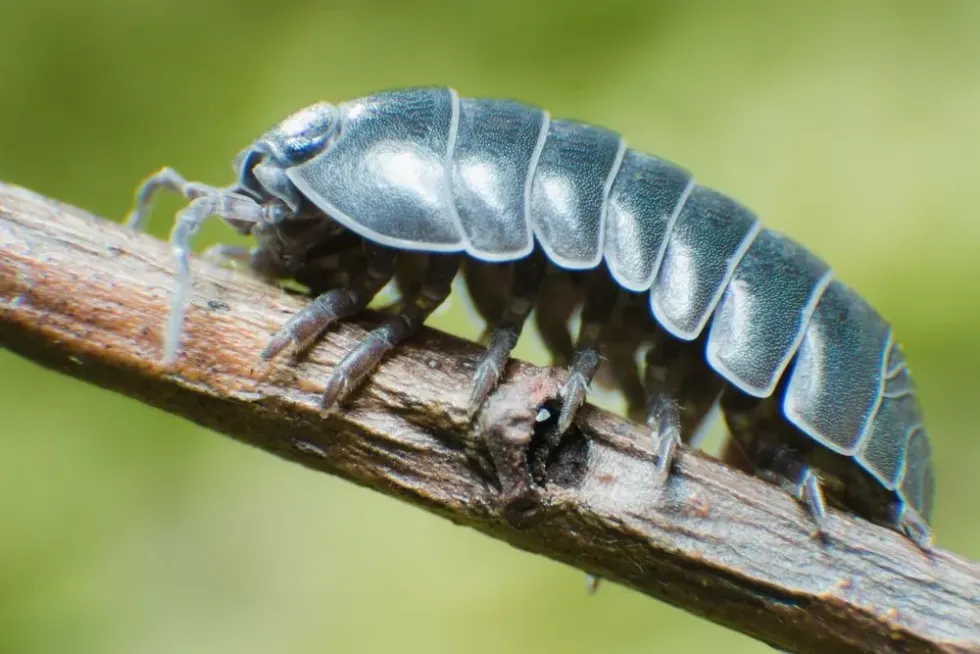The pill bug, Armadillidium vulgare, is a land crustacean of the order Isopoda. Originally found in Europe, these pill bugs are now found across the world in countries like the United States, India, the Mediterranean, and Australia.
Pill bugs are primitive creatures who are related to crabs and shrimps and do not fall under the insect category. These pests thrive in moist regions with high humidity and abundant decomposing organic matter.
They are dark blue-gray with prominent plates, seven pairs of tiny legs, and two pairs of antennae. Females can brood thrice a year to produce batches of eggs in their abdominal pouch. Pill bugs can roll into a ball when disturbed or feel threatened and can stay in that rolled position for a long time.
They are harmless and have economic importance as they help in recycling nutrients in the ecosystem. They are known by different names such as roly-polies, potato bugs, and woodlice.
Read on to learn more about these amazing arthropods and if you like this article, then check out giant water bug and wheel bug.
Pill Bug Interesting Facts
What type of animal is a pill bug?
Pill bugs are terrestrial crustaceans of the order Isopoda.
What class of animal does a pill bug belong to?
Pill bugs belong to the class Malacostraca of the animal kingdom.
How many pill bugs are there in the world?
Pill bugs are abundantly found in gardens, forests, under rocks, and in the soil in fields. However, we cannot determine the exact number of them living on Earth.
Where does a pill bug live?
Originally found in Europe, these land crustaceans are presently found throughout the world including the United States, the Mediterranean, and India.
What is a pill bug's habitat?
Pill bugs prefer a standard Mediterranean climate and temperate agroecosystem, with low illumination and moderate to high humidity. They are crustaceans found on land and prefer moist climates and dry soil with abundant decomposing organic matter.
Pill bugs are also known to avoid areas with low temperatures where the soil is prone to freezing. Human domestic waste can also act as a good habitat for them.
Who do pill bugs live with?
They are social and prefer to live in groups which helps them to survive in the wild. Living in groups can increase their lifespan since individuals who live on their own in the wild have a high mortality rate.
How long does a pill bug live?
The average lifespan of pill bugs (Armadillidium vulgare) in the wild is one and a half years, however, some may live up to a few years. Their average lifespan in captivity is less than one and a half years.
How do they reproduce?
Male Armadillidium vulgares are sexually active most of the time and wait until spring for the females of this species to secrete aggregate pheromones. These pheromones indicate female receptivity and all their sexual activity is limited to this time.
Although female receptivity is mostly noted in spring, they can brood three times a year. Also, the species is adapted to the polygynandry mating system, which means they have no fixed pair.
The mating period is brief after which males leave to mate and molt again and do not take part in the upbringing of young ones.
Females can store sperm from different partners over a whole year for subsequent broods. The eggs are carried by females in a pouch called the marsupium on the abdomen for two to three months.
The hatched eggs or ‘mancas’ emerge from the pouch after three to four days. Young ones may separate from their mothers or stay with their mothers for protection while they go through subsequent molting processes before they become fully independent.
What is their conservation status?
This crustacean is not facing the risk of extinction. They are abundantly found under pieces of natural debris, rocks, and soil. However, as per the International Union for Conservation of Nature or IUCN Red List, their conservation status is Not Evaluated.
Pill Bug Fun Facts
What do pill bugs look like?
These pests have an oval and flattened shape, a cephalic shield like most isopods, a pair of antennae, and unstalked eyes. They are dark blue-gray and have some yellow spotting owing to the presence of different pigments in the body. The prominent plates on these pests give them an armor-like appearance.
Their body is divided into the head, thorax, and abdomen. Pill bugs have seven pairs of legs and these legs are almost invisible. They also have a pair of terminal appendages known as uropods projecting from the tip.
How cute are they?
A pill bug (Armadillidium vulgare) is not harmful and can make quite cute pets. Many children play with pill bugs as it is fun to watch them roll into a ball.
How do they communicate?
The Armadillidium vulgare has limited vision and uses olfactory hairs to locate food and identify other members of the family. Pill bugs mainly communicate with one another with the help of chemical sensing through antennae and also sense their surroundings using this technique.
How big is a pill bug?
A pill bug or Armadillidium vulgare is about 0.03-0.7 in (0.7-18 mm). Adults are three times smaller than giant ants who grow up to 2 in (52 mm).
How fast can a pill bug walk?
Pill bugs are negatively photo-kinetic and they are more active at night when it is dark outside. These pests try to survive by preventing moisture loss from their body and also prevent desiccation.
They move almost twice as much in summer compared to winter. Pill bugs move slowly in areas with high humidity and move faster in drier areas in search of more humid regions.
How much does a pill bug weigh?
Pill bugs are tiny terrestrial crustaceans who weigh around 0.002-0.004 0z (0.06-0.12 g).
What are the male and female names of the species?
Male and female pill bugs do not have distinct names.
What would you call a baby pill bug?
Baby or young pill bugs do not have distinct names.
What do they eat?
Pill bugs live on land and are attracted to areas with abundant decomposing organic matter. Their main source of food is decaying leaf litter of several plant species, and they also eat fruit and garden roots. The high organic content of some soil types is also beneficial to pill bugs.
Are they poisonous?
Pill bugs are non-poisonous. They do not bite and cannot sting.
Would they make a good pet?
Pill bugs are tiny crustaceans who are often kept as pets by children who find it amusing to watch them roll into a tiny ball when disturbed.
Did you know...
Pill bugs prefer areas with high moisture content as they acquire oxygen with their gills and for that, they need their gills to be constantly wet. However, they are non-swimmers and cannot survive underwater for too long.
Pill bugs enter houses mainly through gardens in search of food. Besides insecticides, regular cleaning, dusting, and removing any rotting plants or debris can help get rid of them.
Do pill bugs have eyes?
Yes, pill bugs have unstalked eyes. Their eyes consist of a few simple cells which are capable of light detection.
Are pill bugs beneficial?
Pill bugs are beneficial as they help in biological weed control by performing seed predation. Their food habits and burrowing also help in soil microbe activity and are good for helping in the recycling of various nutrients in the ecosystem.
Here at Kidadl, we have carefully created lots of interesting family-friendly animal facts for everyone to discover! Learn more about some other arthropods including worms, or Dungeness crabs.
You can even occupy yourself at home by drawing one on our pill bug coloring pages.










